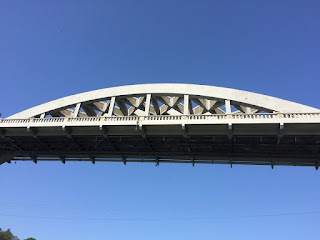The first trip in a boating season is always upriver, which based on our usual plan is a Portland to Oregon City run, via Lake Oswego. The reason for this is safety (going against the current guarantees that you will be carried back to port in the event of engine failure). It has another, often overlooked perk as well: after this first run, we usually travel north instead, past downtown, but this policy guarantees that we get at least one view of the upper Willamette per season.
This first trip is more challenging than most: the trip is early enough in the season that debris, picked up by the Willamette's tributaries during the spring melt, litter the river. Most of these are small sticks, but some are several inches in diameter and sturdy enough to damage a fiberglass hull, or bend a propeller blade. On top of this, the spring salmon run is in full swing and makeshift fishing fleets anchor in the channel, blocking passage. The keen observer will begin to notice more foam in the water, and a distant white noise filling the air.
Oregon City from the water is different than seeing it from land. The river is largely hidden from all but pedestrians in town, and by the same obstacles, the town is hidden from view for those travels on the river. But on the other side of the coin, this allows a boater to see a side of Oregon city that is different from the street view. The aging industry in Oregon City still stands for now, and it is visible from the street, but to a lesser degree.
On both sides of the river, paper companies still stand, their concrete walls back up to the river's edge, smoke stacks dead and quiet, windows dark, riverfront pathways no longer crawling with forklifts hauling boxes of paper. Trees have begun to grow among these ruins, and blackberries overgrow walls, and rusty machinery. Lamps missing their bulbs line the sides of buildings, and power lines still hang from aging steel towers into the once strong industries they were strung to serve. Further north, the Willamette Locks still stand as well, fully functional though boats no longer travel among them.
While exploring this area, on land or by water, you may hear a strange barking, a familiar sound among the docks of ocean bays perhaps, though not expected this far upstream. The source gradually reveals itself, as the sound gives way to brief sightings of brown backs, or the occasional flipper, often mistaken for logs...those legendary logs with flippers. The Sea Lions like to hang out under the 205 bridge...at least, they did when we were there.
 |
| The bridge carrying OR 43, Pacific Highway, over the Willamette River, viewed from the river. --S. Kramer, Photo |
And beyond this, like some sort of mythological object, cloaked in its own mist, is Willamette Falls. The waterfall once harnessed as a hydro-electric power source for the now-silent industries. Its spillways and turbine houses still stand as well, but to my knowledge, these are no longer in use either. The waterfall seems unreal: seeing it there, amid what most Portlanders know as a calm sluggish river through downtown. You don't picture a river like the Willamette to appear like this. Seeing this reminds you of how powerful the river really is: God's way of keeping you from taking the peaceful river in downtown Portland for granted, forcing you to see nature's true potential. Many waterfalls like this once existed on the Columbia as well, though they are now drowned below the dam system on many rivers. Yet Willamette rolls on, a show of power of its own, even if this waterfall no longer generates electricity. In fact, the entire industrial district seems oddly quiet, save for barking of sea lions, road noise, and of course, the waterfall.
While the clanking of heavy industry, steam plumes and chugging of machinery may be gone, plans exist to retain certain historical structures, while redesigning others. Soon businesses and perhaps even condos will replace some of the heavy industry built in among the historic structures in the paper plant. So in a way, while the sun has set on these old paper plants, their story is far from over.
Seeing the falls from below is a humbling experience. While the waterfall is exciting from the higher viewpoints, seeing it as a misty wall of white water is entirely different. The mist prevents you from getting a good perspective, and it may seem bigger than it really is. And of course, the sea lions are a treat, unless you work for fish and wildlife. the heavy industries along the river will likely be seeing new life in years to come.
Seeing the falls from below is a humbling experience. While the waterfall is exciting from the higher viewpoints, seeing it as a misty wall of white water is entirely different. The mist prevents you from getting a good perspective, and it may seem bigger than it really is. And of course, the sea lions are a treat, unless you work for fish and wildlife. the heavy industries along the river will likely be seeing new life in years to come.






No comments:
Post a Comment